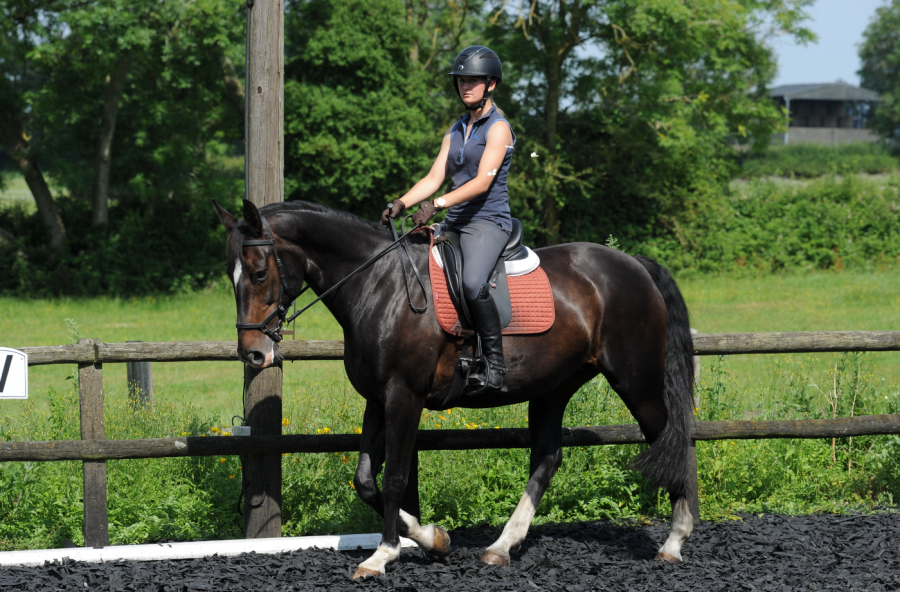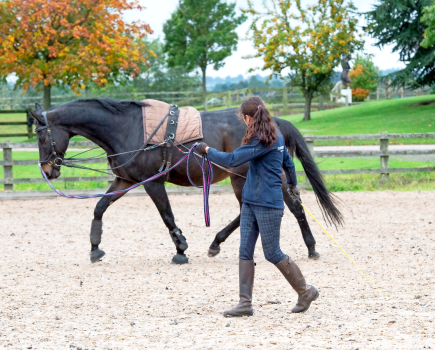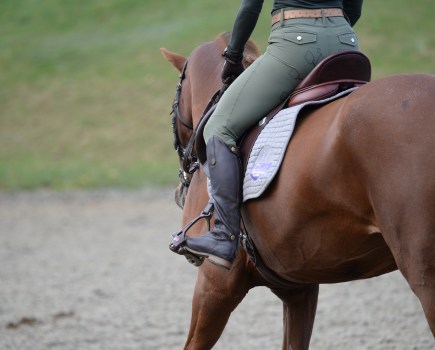Riding is a skill that takes years of practice and dedication to refine — even those riders at the very top of their game and winning Olympic medals are still learning and honing what they do.
There are no shortcuts and we don’t all have access to state-of-the-art simulators to monitor our technique. However, there are simple approaches that can help every rider to assess and improve the way they ride.
Check your straightness
One of the key skills that every rider needs to perfect is sitting symmetrically in the saddle. Not only does sitting straight help your horse to develop straightness, but it’s crucial for reducing the risk of pain, injury and ill health in both horse and rider.
Persistent asymmetry will limit progress. It could be as simple as wearing fitted, striped clothing to help your instructor identify if you’re sitting straight — but ensure that the stripes are lying straight on your body before getting on!
Check your horse’s back, tack and sweat marks when you remove the saddle. Are they even? What about the wear on the heels of your regular riding boots. Do you land more heavily or unevenly on one side? If the wear is uneven then yes, you probably do.
What about the grease marks on the inside calf of your boots when you dismount? If it looks the same on both sides, it’s a good sign that you are using your legs evenly.
Physio/chiropractor checks
When did you last visit a physio or chiropractor for yourself? It’s very easy, and common, for riders to spend money on having their horse routinely checked and treated, but neglect themselves. Yet you are the other 50% of the equation in affecting how well a horse goes, so it’s important to keep your own body in good shape too.
Have yourself and your horse checked out by a physio and/or a chiropractor, preferably one who is also a rider. They can give individual feedback about your particular areas of weakness or asymmetry and suggest exercises that will not only transform your riding, but will also improve your general health and wellbeing in other areas of your life.
Film yourself riding
Still images are a moment in time and so don’t always give an accurate assessment of your riding. Instead, get someone to film you in the saddle from every angle, including from straight ahead and behind. Then watch it back and see what you think. Store the footage and look back on it from time to time, to see what progress you’ve made.
Everyone has a mobile phone these days and the majority take decent videos that will be plenty good enough for this job. Wear light-coloured, well-fitting clothing (this is the time for white gloves) so that your movement patterns are easy to spot.
Write down your targets and then review them every few weeks. You don’t have to be a competitive rider to have goals. Keep a record of where you need to improve and how you are going to do it. You’re more likely to achieve them if you do this.
Improve your strength and suppleness off your horse
Many horse riders are active, outdoorsy people who don’t necessarily want to add gym membership to their list of monthly expenditures, but even a one-off personal training session will help to identify your strengths, weaknesses and imbalances.
If the gym isn’t for you then look at other options, including online classes you can do at home. A simple Google will deliver several ideas for ways you can weight train and improve your body strength at home, and you’ll be surprised what a difference it makes (and how good you’ll feel for it too).
Playing other sports makes a big difference too, and this way you are improving your fitness and strength without realising it, because you’re having too much fun.
Adding more movement patterns to your arsenal will make you more adaptable to your horse — and healthier, too. On-horse training is necessary to develop your reaction time and your aids, but view off-horse training as the foundation that facilitates good riding.
Read up on the theory
If you want to ride well, you really do need to know something about horse movement and biomechanics, such as the sequence of footfalls in walk, trot, canter and gallop, and how these relate to the timing and precision of your aids.
Control your body
Use strengthening and stretching exercises to even out natural asymmetry, and consider taking up an alternative sport or regime that complements riding, such as Pilates, swimming or yoga.
How can you give a precise and well-timed aid if you don’t have good balance and body control?
Look at your tack
Consider whether the tack and equipment you’re using is really helping or hindering you and/or your horse. Make sure it is correctly adjusted, fits well, and is suited to you individually. It’s easy to get used to something and not realise that it’s actually a compromise which is holding you back.
Saddle fit is the obvious starting point. It’s essential that they fit you as well as your horse, but even the fit and comfort of boots and breeches can make a difference.
A correctly fitted bridle that is sympathetic to head anatomy and sensitive facial nerves is crucial for a comfortable horse too.
Ride different horses
If you have the opportunity to ride different horses, then do so as often as you can and take any feedback from said steed with good grace. Our horses often adjust and compensate for our weaknesses when we ride them every day, but a different horse may point out a few harsh but helpful truths because they aren’t used to you.
This is a tricky one, because you may not feel confident about riding other horses, but if you can do it, you’ll learn a lot about the way you ride.
Some equestrian centres/riding schools offer lessons on a schoolmaster, which is a brilliant way to assess your riding in a controlled environment on a horse you know is safe and knows their job well.
Use a mobile app
Mobile apps can help with training and progress. From safe hacking features to learning dressage tests and tracking health, activity and progress, there are plenty out there that can help you to collect your data, refine your systems and increase your knowledge. Have a search to see what’s available and see which would suit you.
Assess your psychological state
Remember that your psychological state plays a big part in how well you ride from day to day, so learning some basic sports psychology techniques will help you to keep control of any negative thoughts and prevent them from influencing your riding.
There is plenty of anecdotal evidence to suggest that the rider’s mood affects their horse, and many riders attribute greater consistency in performance to psychological help.
It has been suggested that a horse may ‘sense’ a rider’s emotional state through the rider’s tension or relaxation of posture in the saddle, contact down the reins and tone of voice.
Other studies demonstrate that perception of a horse’s temperament influences pre-competition nerves in riders and affects performance, with self-confidence being an important ‘moderator’, supporting the relationship between rider psychology and equine performance.
Establish a good working partnership
It is widely recognised that it’s not just the athletic capability of the horse that determines success, but a good working partnership between a well-matched horse and rider.
Assessments made by experienced trainers have shown that the most successful performances are both repeatable and consistent. Controlling your mind really does help you to control your body, and it can therefore make a significant difference to your horse’s way of going.
Main image © Your Horse Library/Kelsey Media Ltd









